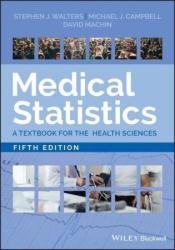 Название: Medical Statistics: A Textbook for the Health Sciences, 5th Edition
Название: Medical Statistics: A Textbook for the Health Sciences, 5th EditionАвтор: Stephen J. Walters, Michael J. Campbell, David Machin
Издательство: Wiley-Blackwell
Год: 2021
Страниц: 448
Язык: английский
Формат: epub (true)
Размер: 15.2 MB
The 5th edition of this popular introduction to statistics for the medical and health sciences has undergone a significant revision, with several new chapters added and examples refreshed throughout the book. Yet it retains its central philosophy to explain medical statistics with as little technical detail as possible, making it accessible to a wide audience.
Helpful multi-choice exercises are included at the end of each chapter, with answers provided at the end of the book. Each analysis technique is carefully explained and the mathematics kept to minimum. Written in a style suitable for statisticians and clinicians alike, this edition features many real and original examples, taken from the authors' combined many years' experience of designing and analysing clinical trials and teaching statistics.
Students of the health sciences, such as medicine, nursing, dentistry, physiotherapy, occupational therapy, and radiography should find the book useful, with examples relevant to their disciplines. The aim of training courses in medical statistics pertinent to these areas is not to turn the students into medical statisticians but rather to help them interpret the published scientific literature and appreciate how to design studies and analyse data arising from their own projects. However, the reader who is about to design their own study and collect, analyse and report on their own data will benefit from a clearly written book on the subject which provides practical guidance to such issues.
Statistics is not only a discipline in its own right but it is also a fundamental tool for investigation in all biological and medical sciences. As such, any serious investigator in these fields must have a grasp of the basic principles. With modern computer facilities there is little need for familiarity with the technical details of statistical calculations. However, a health care professional should understand when such calculations are valid, when they are not and how they should be interpreted.
Medical Statistics and Data Science: Because of the availability of large amounts of data over the last few decades, the term Data Science has emerged to describe the substantial current intellectual effort around research with the goal of extracting information from these data. The type of data currently available in all sorts of application domains is often massive in size, very heterogeneous and far from being collected under designed or controlled experimental conditions. Nonetheless, it contains information, often substantial information, and it has been argued that Data Science is a new interdisciplinary approach that makes maximal use of this information. However, data alone is typically not that informative and Machine Learning from data needs conceptual frameworks. Data Science would seem to encompass statistics. However, we would argue that statistics is crucial for providing conceptual frameworks that enhance the understanding of fundamental phenomena, highlight limitations and provide a formalism for properly founded data analysis, information extraction and quantification of uncertainty, as well as for the analysis and development of algorithms that carry out these key tasks.
Data Science is empirical, reliant on large data sets, whereas one of the key successes of statistics is doing inference on relatively small data sets, such as those available in agriculture and laboratories. Data Science is often used for prediction, and the idea is that with the vast amounts of data now available electronically (such as that provided by national health services) one can look at empirical relationships and build up accurate predictors, such as how drugs will behave in individuals. These predictions are often highly successful, but lacking models it can be difficult to know why it makes some predictions, and how generalizable the predictions might be. Data Science is related to the concept of ‘Big Data’. However, simply because a sample is large does not mean it is unbiased.
The practical guidance provided by this book will be of use to professionals working in and/or managing clinical trials, in academic, public health, government and industry settings, particularly medical statisticians, clinicians, trial co-ordinators. Its practical approach will appeal to applied statisticians and biomedical researchers, in particular those in the biopharmaceutical industry, medical and public health organisations.
Скачать Medical Statistics: A Textbook for the Health Sciences, 5th Edition